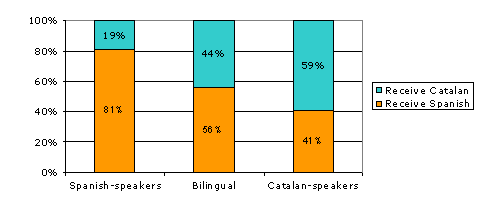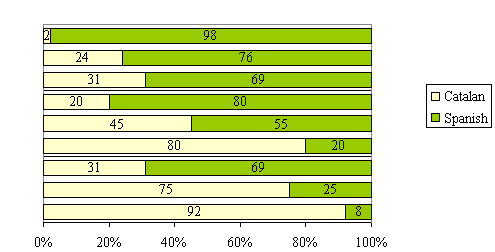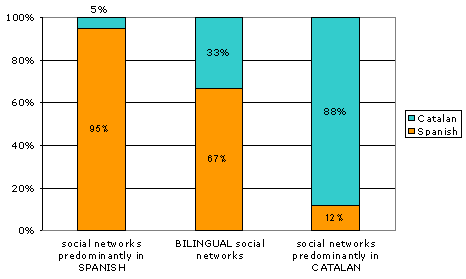
Factors
explaining informal linguistic usage among Catalan schoolchildren:
initial language, social networks, competence and vehicular language
for teaching, by Mireia Galindo i F. Xavier Vila i Moreno |
||||
| CONTINUA |
GRAPH 4. LANGUAGE OF SPEAKING TURNS RECEIVED BY EACH LINGUISTIC GROUP OF FAMILIES
Source: Vila and Galindo body of data When the data for the family languages of the participants in the conversation is cross-referenced, the point to which the linguistic identity of the interlocutor conditions the choice of language can be seen (graph 5). Interactions between children from Catalan-speaking families are largely carried on in Catalan, and, between Spanish-speakers, they are largely in Spanish. In conversation between bilinguals, both languages can be heard, although Spanish predominates slightly. GRAPH 5. Language of the
speaking turns exchanged by Spanish-speakers,
Source: Vila and Galindo body of data Where significant differences in behaviour between Catalan and Spanish-speakers are observed is in the interactions between children with different family languages: so, Catalan-speakers adapt to the language of their Spanish-speaking classmates in 69% of speaking turns, while the Spanish-speakers address the Catalan-speakers in Catalan in only 31% of cases. The outstanding percentages are undoubtedly due to the rule of convergence to Spanish, confirmed throughout the 20TH century in the entire Catalan domain south of the Pyrenees. This rule establishes that Catalan-speakers use Catalan for speaking among themselves and switch to Spanish when it comes to addressing Spanish-speaking or unknown interlocutors, while Spanish-speakers can use Spanish actively, regardless of the linguistic identity of their interlocutor. However, it must be borne in mind that, although the rule is followed, it is not followed absolutely: not all Catalan-speakers talk to Spanish-speakers exclusively in Catalan (they actively use Catalan in at least 3 out of 10 turns), nor do all Spanish-speakers always address their Catalan-speaking classmates in their own language (they maintain Spanish in 7 out of 10 speaking turns).(5) Graph 4 includes the data from all the 52 schools analysed. However, if the data is analysed in greater detail, quite different behaviours are observed depending on the environmental linguistic conditions or the demo-linguistic composition of the schools (for more, see Vila and Galindo 2008). So, in schools where the proportion of Catalan-speakers does not exceed 30%, Spanish is mainly used, even in conversations in which both interlocutors are Catalan-speakers. Meanwhile, at centres with more than 70% Catalan-speaking pupils, the use of Catalan predominates. It must be said, however, that, in this latter type of school, Catalan has not penetrated conversations between Spanish-speakers so deeply. If the language of the home influences the informal linguistic usages of schoolchildren, the predominant language of their social networks conditions them still further. 95% of the speaking turns of children who declare that they mostly use Spanish are actually in that language, and 88% of the turns of those who say they basically use Catalan are spoken in Catalan (graph 6). Those who say they have bilingual social networks in practice speak more Spanish (67% of turns) than Catalan (33%). GRAPH 6:Language of speaking
turns according to the speakers' social networks
Source: Vila and Galindo body of data 3.2. The relationship between usage and linguistic competences The experimental data collected in the project (level of comprehension in Catalan and Spanish among the pupils) allows us to test the point to which linguistic competence and the use of a language are two sides of the same coin. In the study, the improvement in oral knowledge in each language corresponds to an increase in linguistic choice of that language (Graph 7 and 8; the results in the first and last column should be ignored, as they include a low number of speaking turns). |
||


